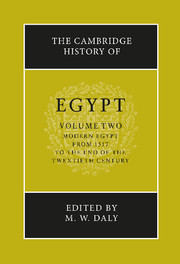Book contents
- Frontmatter
- 1 Ottoman Egypt, 1525–1609
- 2 Egypt in the seventeenth century
- 3 Egypt in the eighteenth century
- 4 Culture in Ottoman Egypt
- 5 The French occupation of Egypt, 1798–1801
- 6 The era of Muhammad ’Ali Pasha, 1805–1848
- 7 Egypt under the successors of Muhammad ’Ali
- 8 The Egyptian empire, 1805–1885
- 9 The ‘Urabi revolution and the British conquest, 1879–1882
- 10 The British occupation, 1882–1922
- 11 Social and economic change in the “long nineteenth century”
- 12 The liberal age, 1923–1952
- 13 Egypt: society and economy, 1923–1952
- 14 Republican Egypt interpreted: revolution and beyond
- 15 Modern Egyptian culture in the Arab world
- Select Bibliography
- Index
- References
1 - Ottoman Egypt, 1525–1609
Published online by Cambridge University Press: 28 March 2008
- Frontmatter
- 1 Ottoman Egypt, 1525–1609
- 2 Egypt in the seventeenth century
- 3 Egypt in the eighteenth century
- 4 Culture in Ottoman Egypt
- 5 The French occupation of Egypt, 1798–1801
- 6 The era of Muhammad ’Ali Pasha, 1805–1848
- 7 Egypt under the successors of Muhammad ’Ali
- 8 The Egyptian empire, 1805–1885
- 9 The ‘Urabi revolution and the British conquest, 1879–1882
- 10 The British occupation, 1882–1922
- 11 Social and economic change in the “long nineteenth century”
- 12 The liberal age, 1923–1952
- 13 Egypt: society and economy, 1923–1952
- 14 Republican Egypt interpreted: revolution and beyond
- 15 Modern Egyptian culture in the Arab world
- Select Bibliography
- Index
- References
Summary
The period 1525–1609 covers approximately the first third of the history of Ottoman Egypt, and has distinct characteristics. It starts with the pacification of the country after the suppression of Ahmad Pasha al-Kha’in’s revolt and of the serious disturbances by Bedouin tribes that followed it, and the promulgation of the code for the government of Egypt, Qanun-name-i Misir by the grand vizier Ibrahim Pasha. Egypt remained tranquil and passive under Ottoman rule that was firm and effective. Around the late 1580s, however, the army became unruly owing to economic difficulties and in the context of the general decline of the Ottoman empire. After that the viceroys had increasing difficulty maintaining their rule. The whole period, which can be described as the ascendancy of the viceroys (or pashas), ends in 1609 with suppression of a serious soldiers’ rebellion by a strong viceroy. New political forces came to the fore, and the viceroys acted merely as formal representatives of the sultan.
The main sources
Historians attempting to describe the period face a dilemma of meager source materials. Egypt during the Mamluk period is unusually rich in historical sources – chronicles, biographical dictionaries, handbooks, and the like. The last decades before the Ottoman occupation, the conquest itself, and the next six years (until Dhu l-Hijja 928/November 1522) are superbly covered by Ibn Iyas, one of the best representatives of the great Egyptian historiographic tradition. ’Abd al-Samad al-Diyarbakri, an Ottoman judge who came to Egypt with Salim’s army, stayed there to serve as a qadi. His chronicle is a translation into Turkish of Ibn Iyas’s work, with significant changes, and then a detailed continuation of the chronicle for a period of two-and-a-half years (up to Shawwal 931/July 1525).
- Type
- Chapter
- Information
- The Cambridge History of Egypt , pp. 1 - 33Publisher: Cambridge University PressPrint publication year: 1998



